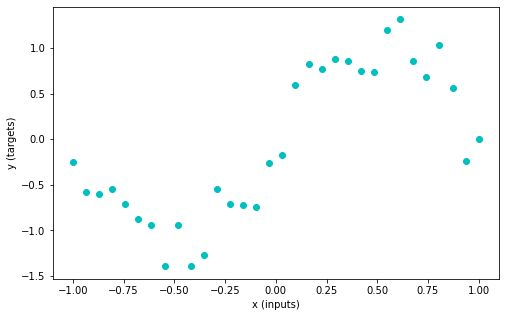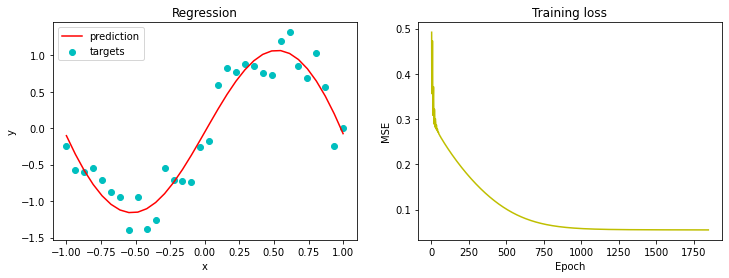Lecture 4: Feedforward Neural Networks and Backpropagation Part 2 Code
Contents
Lecture 4: Feedforward Neural Networks and Backpropagation Part 2 Code #
#@title
from ipywidgets import widgets
out1 = widgets.Output()
with out1:
from IPython.display import YouTubeVideo
video = YouTubeVideo(id=f"XV20CvRsIJU", width=854, height=480, fs=1, rel=0)
print("Video available at https://youtube.com/watch?v=" + video.id)
display(video)
display(out1)
#@title
from IPython import display as IPyDisplay
IPyDisplay.HTML(
f"""
<div>
<a href= "https://github.com/DL4CV-NPTEL/Deep-Learning-For-Computer-Vision/blob/main/Slides/Week_4/DL4CV_Week04_Part02.pdf" target="_blank">
<img src="https://github.com/DL4CV-NPTEL/Deep-Learning-For-Computer-Vision/blob/main/Data/Slides_Logo.png?raw=1"
alt="button link to Airtable" style="width:200px"></a>
</div>""" )
Imports
import torch
import numpy as np
from torch import nn
from math import pi
import matplotlib.pyplot as plt
from mpl_toolkits.axes_grid1 import make_axes_locatable
import random
Helper Function for Plotting
def ex3_plot(model, x, y, ep, lss):
"""
Plot training loss
Args:
model: nn.module
Model implementing regression
x: np.ndarray
Training Data
y: np.ndarray
Targets
ep: int
Number of epochs
lss: function
Loss function
Returns:
Nothing
"""
f, (ax1, ax2) = plt.subplots(1, 2, figsize=(12, 4))
ax1.set_title("Regression")
ax1.plot(x, model(x).detach().numpy(), color='r', label='prediction')
ax1.scatter(x, y, c='c', label='targets')
ax1.set_xlabel('x')
ax1.set_ylabel('y')
ax1.legend()
ax2.set_title("Training loss")
ax2.plot(np.linspace(1, epochs, epochs), losses, color='y')
ax2.set_xlabel("Epoch")
ax2.set_ylabel("MSE")
plt.show()
Helper Function for random seed
def set_seed(seed=None, seed_torch=True):
"""
Function that controls randomness. NumPy and random modules must be imported.
Args:
seed : Integer
A non-negative integer that defines the random state. Default is `None`.
seed_torch : Boolean
If `True` sets the random seed for pytorch tensors, so pytorch module
must be imported. Default is `True`.
Returns:
Nothing.
"""
if seed is None:
seed = np.random.choice(2 ** 32)
random.seed(seed)
np.random.seed(seed)
if seed_torch:
torch.manual_seed(seed)
torch.cuda.manual_seed_all(seed)
torch.cuda.manual_seed(seed)
torch.backends.cudnn.benchmark = False
torch.backends.cudnn.deterministic = True
print(f'Random seed {seed} has been set.')
# In case that `DataLoader` is used
def seed_worker(worker_id):
"""
DataLoader will reseed workers following randomness in
multi-process data loading algorithm.
Args:
worker_id: integer
ID of subprocess to seed. 0 means that
the data will be loaded in the main process
Refer: https://pytorch.org/docs/stable/data.html#data-loading-randomness for more details
Returns:
Nothing
"""
worker_seed = torch.initial_seed() % 2**32
np.random.seed(worker_seed)
random.seed(worker_seed)
Helper Function for Device
def set_device():
"""
Set the device. CUDA if available, CPU otherwise
Args:
None
Returns:
Nothing
"""
device = "cuda" if torch.cuda.is_available() else "cpu"
if device != "cuda":
print("GPU is not enabled in this notebook. \n"
"If you want to enable it, in the menu under `Runtime` -> \n"
"`Hardware accelerator.` and select `GPU` from the dropdown menu")
else:
print("GPU is enabled in this notebook. \n"
"If you want to disable it, in the menu under `Runtime` -> \n"
"`Hardware accelerator.` and select `None` from the dropdown menu")
return device
SEED = 2022
set_seed(seed=SEED)
DEVICE = set_device()
Random seed 2022 has been set.
GPU is enabled in this notebook.
If you want to disable it, in the menu under `Runtime` ->
`Hardware accelerator.` and select `None` from the dropdown menu
PyTorch’s Neural Net module (nn.Module)#
PyTorch provides us with ready-to-use neural network building blocks, such as layers (e.g., linear, recurrent, etc.), different activation and loss functions, and much more, packed in the torch.nn module. If we build a neural network using torch.nn layers, the weights and biases are already in requires_grad mode and will be registered as model parameters.
For training, we need three things:
Model parameters: Model parameters refer to all the learnable parameters of the model, which are accessible by calling
.parameters()on the model. Please note that NOT all therequires_gradtensors are seen as model parameters. To create a custom model parameter, we can usenn.Parameter(A kind of Tensor that is to be considered a module parameter).Loss function: The loss that we are going to be optimizing, which is often combined with regularization terms (coming up in few days).
Optimizer: PyTorch provides us with many optimization methods (different versions of gradient descent). Optimizer holds the current state of the model and by calling the
step()method, will update the parameters based on the computed gradients.
You will learn more details about choosing the right model architecture, loss function, and optimizer later in the course.
Training loop in PyTorch#
We use a regression problem to study the training loop in PyTorch.
The task is to train a wide nonlinear (using \(\tanh\) activation function) neural net for a simple \(\sin\) regression task. Wide neural networks are thought to be really good at generalization.
Generate Sample Data
set_seed(seed=SEED)
n_samples = 32
inputs = torch.linspace(-1.0, 1.0, n_samples).reshape(n_samples, 1)
noise = torch.randn(n_samples, 1) / 4
targets = torch.sin(pi * inputs) + noise
plt.figure(figsize=(8, 5))
plt.scatter(inputs, targets, c='c')
plt.xlabel('x (inputs)')
plt.ylabel('y (targets)')
plt.show()
Random seed 2022 has been set.

Let’s define a very wide (512 neurons) neural net with one hidden layer and nn.Tanh() activation function.
class WideNet(nn.Module):
"""
A Wide neural network with a single hidden layer
Structure is as follows:
nn.Sequential(
nn.Linear(1, n_cells) + nn.Tanh(), # Fully connected layer with tanh activation
nn.Linear(n_cells, 1) # Final fully connected layer
)
"""
def __init__(self):
"""
Initializing the parameters of WideNet
Args:
None
Returns:
Nothing
"""
n_cells = 512
super().__init__()
self.layers = nn.Sequential(
nn.Linear(1, n_cells),
nn.Tanh(),
nn.Linear(n_cells, 1),
)
def forward(self, x):
"""
Forward pass of WideNet
Args:
x: torch.Tensor
2D tensor of features
Returns:
Torch tensor of model predictions
"""
return self.layers(x)
We can now create an instance of our neural net and print its parameters.
# Creating an instance
set_seed(seed=SEED)
wide_net = WideNet()
print(wide_net)
Random seed 2022 has been set.
WideNet(
(layers): Sequential(
(0): Linear(in_features=1, out_features=512, bias=True)
(1): Tanh()
(2): Linear(in_features=512, out_features=1, bias=True)
)
)
# Create a mse loss function
loss_function = nn.MSELoss()
# Stochstic Gradient Descent optimizer (you will learn about momentum soon)
lr = 0.003 # Learning rate
sgd_optimizer = torch.optim.SGD(wide_net.parameters(), lr=lr, momentum=0.9)
The training process in PyTorch is interactive - you can perform training iterations as you wish and inspect the results after each iteration.
Let’s perform one training iteration. You can run the cell multiple times and see how the parameters are being updated and the loss is reducing. This code block is the core of everything to come: please make sure you go line-by-line through all the commands and discuss their purpose with your pod.
# Reset all gradients to zero
sgd_optimizer.zero_grad()
# Forward pass (Compute the output of the model on the features (inputs))
prediction = wide_net(inputs)
# Compute the loss
loss = loss_function(prediction, targets)
print(f'Loss: {loss.item()}')
# Perform backpropagation to build the graph and compute the gradients
loss.backward()
# Optimizer takes a tiny step in the steepest direction (negative of gradient)
# and "updates" the weights and biases of the network
sgd_optimizer.step()
Loss: 0.675656795501709
Training Loop#
Using everything we’ve learned so far, we ask you to complete the train function below.
def train(features, labels, model, loss_fun, optimizer, n_epochs):
"""
Training function
Args:
features: torch.Tensor
Features (input) with shape torch.Size([n_samples, 1])
labels: torch.Tensor
Labels (targets) with shape torch.Size([n_samples, 1])
model: torch nn.Module
The neural network
loss_fun: function
Loss function
optimizer: function
Optimizer
n_epochs: int
Number of training iterations
Returns:
loss_record: list
Record (evolution) of training losses
"""
loss_record = [] # Keeping recods of loss
for i in range(n_epochs):
optimizer.zero_grad() # Set gradients to 0
predictions = model(features) # Compute model prediction (output)
loss = loss_fun(predictions, labels) # Compute the loss
loss.backward() # Compute gradients (backward pass)
optimizer.step() # Update parameters (optimizer takes a step)
loss_record.append(loss.item())
return loss_record
set_seed(seed=2022)
epochs = 1847 # Cauchy, Exercices d'analyse et de physique mathematique (1847)
losses = train(inputs, targets, wide_net, loss_function, sgd_optimizer, epochs)
ex3_plot(wide_net, inputs, targets, epochs, losses)
Random seed 2022 has been set.

Acknowledgements
Code adopted from the Deep Learning Summer School offered by Neuromatch Academy


